First Flight: Doug Henson
![]()
First Flight: Doug Henson |
|
by Doug Henson
|
This article appeared in the March 2004 issue of the Falco Builders Letter. |
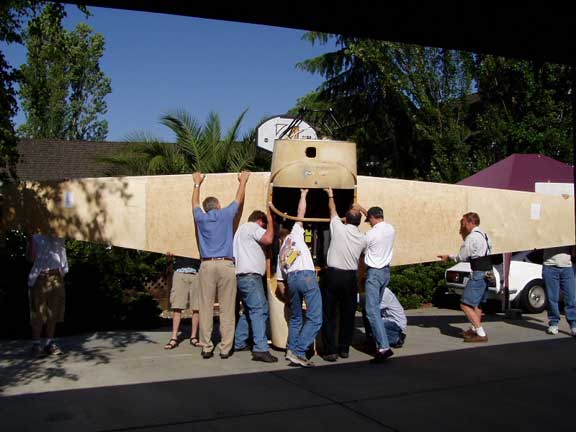
I had thoughts about owning my own airplane many years ago. In fact, my dream was to find a T-34 to rebuild, and I had actually scouted the country to find one. Reality settled in, though, when I realized neither the money nor the time was available to achieve the dream at that time. Twenty years later the stars aligned, and I got serious about building my own airplane. I looked at a lot of options, but was not excited about any of the sheet metal or fiberglass aircraft I could build. I have always been a wood craftsman, so when I discovered the Falco, it was a match. I quickly contacted two nearby owners (Dan Dorr and Larry Black) to visit their projects. In addition, Larry offered to give me a ride, and I was hooked. The Falco flies like the high performance aircraft I was accustomed to in the Air Force. I realized immediately during that flight that it was a real airplane and that I just had to build and own one.
My project started in January 2000 with a goal to finish within five years. N48EL lived in my garage for almost four years. I am fortunate in that I work with two other aircraft experts. Dave Neustel is building a Thorpe T-18 while Yon Perras and his brother have restored a Staggerwing and a Lockheed Electra (which won an award at Oshkosh a few years ago). Dave and Yon provided lots of advice when I needed it during construction. As we all know, building a Falco takes lots of friends.

The construction manual is right about building your airplane at home. When I moved to the Livermore Airport over the Thanksgiving weekend in 2003, progress plummeted. Even though I only live three miles from the airport, the hassle of driving to the hangar and never having the right tool at the right time was maddening. While the project was at home, it was so easy to walk into the garage to work on it-even if I only had 30 minutes between other chores.
During the summer/fall of 2003, the light at the end of the tunnel appeared. The only real change in plans I made was during that summer when I decided to fly before final painting. My original intention was to complete everything before flying. However, I discovered after painting the control surfaces that my painting skills were not up to the standard I would accept. Orange peel would not do on this aircraft. Winter was also approaching, so I decided to forego the final painting at that time. Instead, my focus turned to getting in the air and worrying about painting later when warm weather would be available. Off we went to the airport.

Final assembly was complete in late January 2004. Upon contacting the Oakland FSDO, I set up a visit by an inspector. Horror stories from other builders were completely unfounded. My inspector could not have been any more helpful. After receiving my request letter in the mail, he contacted me by telephone and discussed what he was looking for when he visited. We picked a mutual date, and I met him at the hangar. During the inspection, he thoroughly reviewed my documentation and the operating limitations on the aircraft. There was only one slight rewording I requested, he agreed, and we were done. His inspection of the aircraft was minimal, looking primarily for the required placards and identification plate.
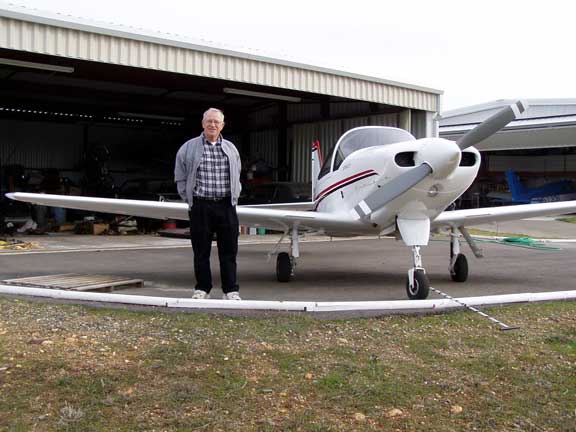
|
Larry Black |
My flight preparation included ground systems checks, taxi testing, and controls effectiveness tests (aka high speed taxi tests). Engine and engine controls checkout took place in front of the hangar. I put about 0.5 hours on the tach over several days to satisfy myself that everything worked. I discovered two problems during this phase. First, the Shadin MicroFlo fuel flow system did not register fuel flow. This was not a safety-of-flight issue, so I put off fixing that until later (it turned out to be a factory setting problem, not an installation error).
The important problem I found was that the fuel line between the firewall and the gascolator leaked. I had not sealed the fitting correctly, so had to replace the tube and fittings, then retest. For me, it was absolutely essential to ensure before flight that the mixture, prop, and other controls were hooked up correctly, and they do what they should to the engine. These preflight checkouts also included alternator operation, fuel flow tests from both tanks while checking for leaks, and electrical tests (lights, avionics, etc.). In short, I checked that every system did what it was designed to do before moving the aircraft under its own power. There were two very good references for this testing-the Falco Flight Test Guide and AC 90-89 Amateur-Built Aircraft and Ultralight Flight Testing Handbook.
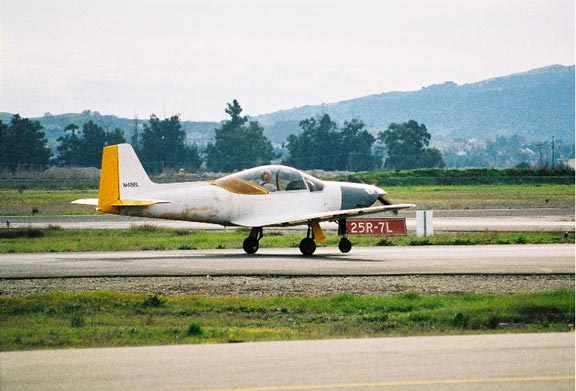
|
Runway 7L at Livermore was the active. Check out the cool quad-color paint scheme. |
Then one morning I played hooky from work and motored around the Livermore airpatch for taxi testing. Low speed taxiing was completed as I found my way to the rose for mag compass calibration. That's at the other end of the airport from my hangar, so I got plenty of turning and brake conditioning. Then, it was on to the runway for some high speed taxi tests.
As described in the two references, these tests are designed to check that the nose goes right when moving the right foot, the nose rises when pulling the stick back, etc. It is also the first opportunity to run the engine at full power and look for "green" indications. For me, it took five trips down LVK's shortest runway to get everything done. Near the end of the tests, I was reaching speeds around 50-60 knots, requiring me to pay close attention so that I did not fly. Improper stick movement could easily have put me in the air prematurely, and that was not a part of the plan. I am a stickler for following my plan without deviation, else I could have found myself flying before I was prepared.
That put me in the position of having nothing standing in my way of flying except for the weather. A couple of weeks of low ceilings and/or rain left me plenty of quality time to get myself and the airplane ready. Just like in the Air Force, my weather days were spent in my Falco "trainer". I spent several hours in the cockpit practicing procedures as well as preparing for and visualizing my first flight by moving controls, switches, and levers. That included preparations for emergencies of all kinds.
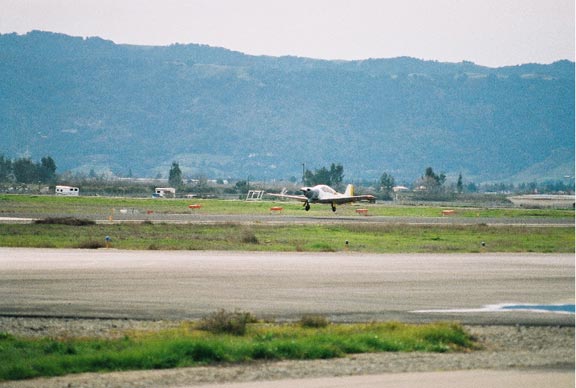
|
Lift off. |
I never considered asking anyone else to conduct the first flight of my Falco. My philosophy was simple-there is no one more dedicated to building a quality airplane that meets all specs than me since I will be the primary pilot. In addition, this is a well proven aircraft, so the only real issue to consider was for me to acquire the skills to fly it. In other words, if I build it correctly and I know how to fly it, that's all it takes.
My plan was to get a few landings in someone else's Falco, then do the deed in mine. As far as handling qualities, I knew the Falco was light on the controls which is one of the reasons I decided to build one in the first place. My flying experience in the Air Force gave me plenty of time in high performance aircraft, so the only unknown for me was landing peculiarities.
My insurance company wanted me to get an hour of flight instruction in the Falco with a CFI. With some help from the agent, I convinced the underwriter that was near impossible. The counter offer I made was for me to get a minimum of three hours dual time with an experienced Falco pilot. They agreed. I contacted Larry Black who had volunteered to help when I visited him during construction and again last fall at the West Coast Falco Fly In. He gave me stick time with lots of guidance on power settings, landing picture, etc. and, after seven landings, I was ready.
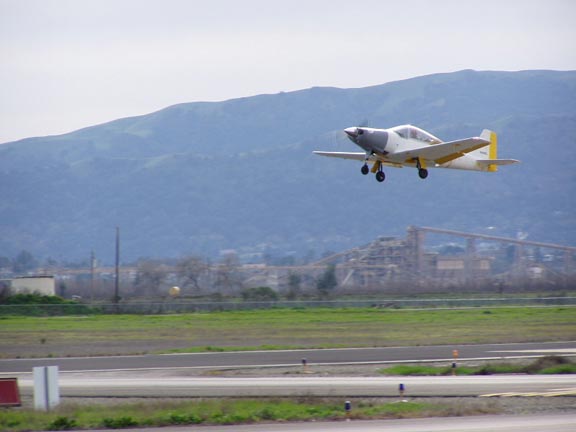
|
Climbs like a bat out of hell. |
The fun part about the first flight was preparation. I have a friend, Dennis Johnson, who plans to start building an airplane this year. He has been helping some with my project and provided support for final inspections. Given our similar backgrounds (we met in USAF pilot training), we work well together. I checked and rechecked the airframe, engine, and all subsystems. Then he looked at things, critically challenged my plans, and quizzed me about emergency procedures while airborne.
Preparation and planning had taken weeks, then it was time to launch on Valentine's Day, 2004. The sun was shining after a rain storm the day before, so viz was great. I strapped N48EL onto my back and headed for takeoff. After alignment onto the active runway and start of takeoff roll, things happened quickly. Some of that is attributable to my state of mind (adrenalin, etc.), but also to the acceleration of the Falco. I was airborne almost before I knew it. A word to future test pilots-plan, replan, then plan again. You will be surprised at how quickly things happen in the fast paced environment of a first flight. It did for me, but with all of the preparation ahead of time, response was rote and things went as planned.
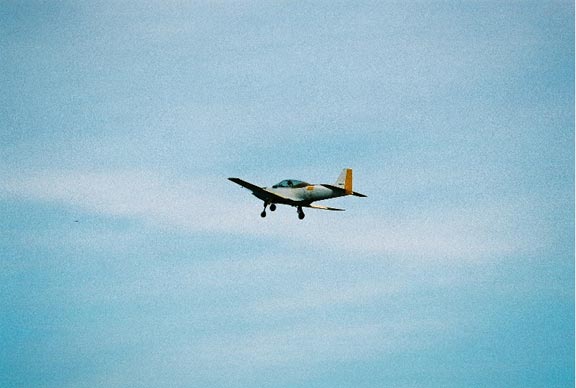
Another word to future test pilots-the Falco does not fly like your average Cessna. As I've stated before, it is a high performance aircraft, and you need the skills to fly it.
My plan was to climb on runway heading to pattern altitude, and if things still looked okay, then exit the traffic pattern to orbit in the northeast part of LVK's Class D airspace. All instruments showed "in the green", so off I went. As I settled into flying, what a wonderful feeling it all was. There I was at altitude in an airplane I had built! Life just couldn't get any better than that.
During my stick time with Larry, he had told me that my Falco would fly essentially identical to his. He was right. The only small difference I noted was that mine climbs a bit faster due to my use of the IO-360 powerplant.
After about 30 minutes of drilling some holes in the sky, practicing slow flight, exploring the stall characteristics, etc., I was ready to land. Again, the landing looked identical to those I conducted in Larry's Falco, so my first landing in my own aircraft was a piece of cake. At shutdown, my family and friends greeted me with hugs and high-fives, then we all went home to celebrate this once-in-a-lifetime experience.
|
|
Go back to Doug Henson